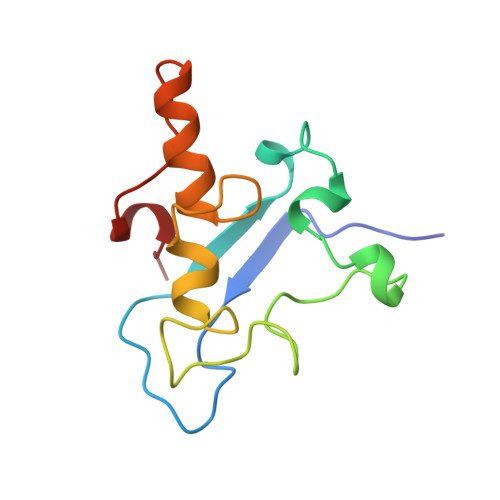Crystal structure of a dimeric octaheme cytochrome c3 (M(r) 26,000) from Desulfovibrio desulfuricans Norway.
Czjzek, M., Guerlesquin, F., Bruschi, M., Haser, R.(1996) Structure 4: 395-404
- PubMed: 8740362
- DOI: https://doi.org/10.1016/s0969-2126(96)00045-7
- Primary Citation of Related Structures:
1CZJ - PubMed Abstract:
The octaheme cytochrome C3 (M(r) 26,000; cc3) from Desulfovibrio desulfuricans Norway is a dimeric cytochrome made up of two identical subunits, each containing four heme groups. It is involved in the redox transfer chain of sulfate-reducing bacteria, which links the periplasmic oxidation of hydrogen to the cytoplasmic reduction of sulfate. The amino-acid sequence of cc3 shows similarities to that of the tetraheme cytochrome c3 (M(r) 13,000; c3) from the same bacteria. Structural analysis of cc3 forms a basis for understanding the precise roles of the multiheme-containing redox proteins and the reason for the presence of several different multiheme cytochromes in one bacterial strain. The crystal structure of cytochrome cc3 has been determined at 2.16 A resolution. The subunits display the c3 structural fold with significant amino-acid substitutions, relative to the tetraheme cytochromes c3, in the regions of the dimer interface. The identical subunits are related by a crystallographic twofold axis, with one heme of each subunit in close contact. The overall structure and the environments of the different heme groups are compared with those of the tetraheme cytochromes c3. A common scheme for interactions between these types of cytochrome and their redox partners involves the interaction of a heme crevice, surrounded by positively charged lysine residues, with acidic residues surrounding the redox partner's functional group. Despite the relatively acidic character of cytochrome cc3, the crevice of one heme is surrounded by a high number of positively charged residues, in the same manner as has been reported for cytochromes c3. The environment of this heme is formed by four flexible surface loops which are variable in length and orientation in the different c3-type cytochromes although the overall structural folds are very similar. It has been proposed that this region, adapted in topology and charge, is the interaction site for physiological partners and is also most likely to be the interaction site in the dimeric cytochrome cc3.
Organizational Affiliation:
Laboratoire de Cristallographie et Cristallisation des Macromolécules Biologiques, URA 1296, CNRS, Marseille, France.
















